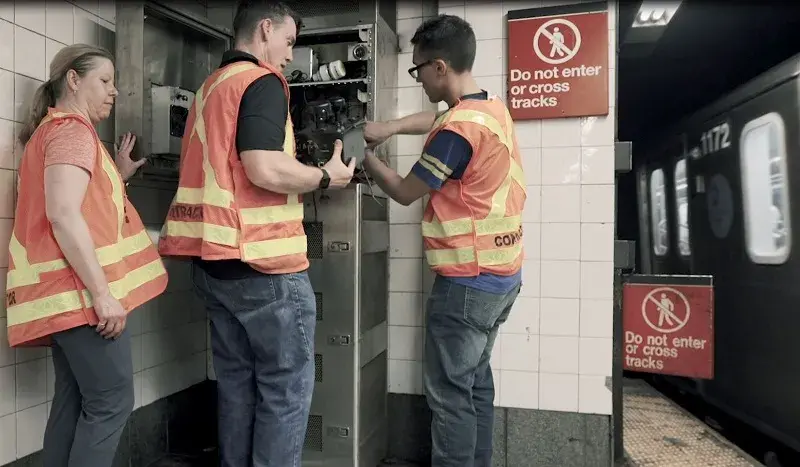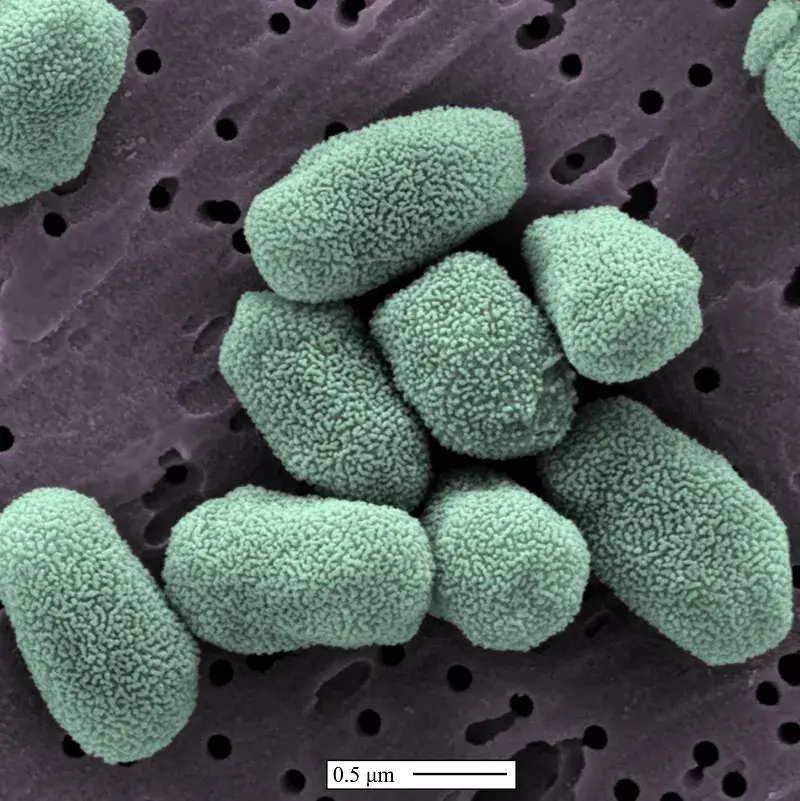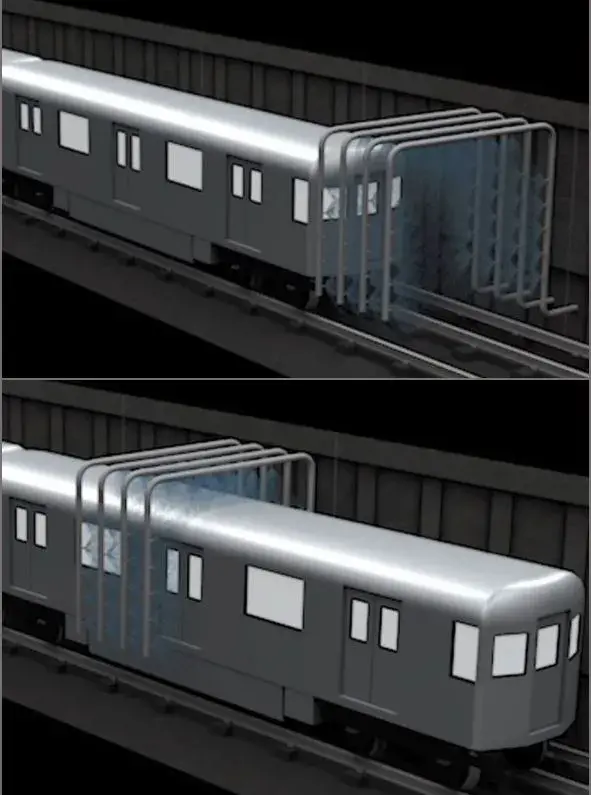 Public transportation is the backbone of a city. It moves people safely and quickly from place to place for work, school, events, meetings, and running errands. It connects businesses and families together.
Public transportation is the backbone of a city. It moves people safely and quickly from place to place for work, school, events, meetings, and running errands. It connects businesses and families together.
Keeping these systems safe without impeding or slowing the flow of traffic is critical. So how do you monitor public transit spaces for potential biological or chemical hazards without slowing anyone down?
The Department of Homeland Security (DHS) works tirelessly with its public transportation partners to help make transit systems safer while maintaining their efficiency. The DHS Science and Technology Directorate (S&T) has been developing and perfecting various sensor technologies for public transit through the Urban Security Initiative, a portfolio of collaborative projects with the City of New York, to help protect high-density urban areas against threats. One such collaboration, called Underground Transport Restoration, involved a simulated airborne health hazard that was dispersed and measured in the NYC subway system in May 2016. This work, ongoing since 2010, uses science, technology and simulation modelling to help make public transit safer, even during the pandemic.
Quickly detecting and mitigating biological or chemical threats in the subway is critical for preventing the spread of hazardous materials should the unthinkable occur. However, technologies that are currently in use do not perform fast enough for a subway environment, and false alarms may cause unnecessarily disruptive and expensive closures.
Chemical and Bio-Defense Testbed addresses chemical and biological threats
Fast forward to present day and S&T’s latest collaborative project—Chemical and Bio-Defense Testbed (CBT)—which tests and evaluates cost-effective technologies to detect chemical and biological threats inside an actual subway environment, as well as mitigation strategies if threats are detected. This project is a collaboration between S&T, the Massachusetts Institute of Technology (MIT) Lincoln Laboratory, the Metropolitan Transportation Authority (MTA) New York City Transit (NYCT), New York Police Department, Port Authority of New York and New Jersey, and the New York City Department of Health and Mental Hygiene.
“As North America’s leader in adopting technology for improving transportation safety and reliability, the MTA values its partnership with DHS to ensure that riders are protected from emerging threats,” said Mark Dowd, MTA Chief Innovation Officer. “Out of an abundance of caution, we embrace S&T’s expertise in evaluating detection protocols that could provide early notification should someone seek to threaten our customers.”
A testbed is a real-world environment where researchers can see how technology performs. Several testbeds already exist in New York, examining new technologies for different hazards. The CBT is designed to detect a wide range of threats with the help of chemical and biological sensor technologies. The initial phase of CBT focuses on biological threats (such as Bacillus anthracis, the anthrax-causing bacteria), as they are more difficult to detect early (during the incubation period) and can multiply for days before being noticed. Contrarily, when a chemical hazard is released, the effects are typically immediately visible.
The current testbed consists of eight secured cabinets in a NYC subway station. The biodetection sensors are not yet installed, but inside the cabinets presently lie environmental sensors, power and communication equipment, and a nearby command center that will support the functioning of the sensors.
 After the new biodetection technology is installed (sourced from government, academia and the private sector), researchers from S&T and MIT Lincoln Laboratory will gather data to assess the technologies’ performance. These data will include false alarm rate, probability of detection, time to detection and cost of ownership, as well as environmental data gathered from the support equipment like temperature, pressure, relative humidity, wind speed and direction. The data can also be used for technology improvements.
After the new biodetection technology is installed (sourced from government, academia and the private sector), researchers from S&T and MIT Lincoln Laboratory will gather data to assess the technologies’ performance. These data will include false alarm rate, probability of detection, time to detection and cost of ownership, as well as environmental data gathered from the support equipment like temperature, pressure, relative humidity, wind speed and direction. The data can also be used for technology improvements.
“To keep up with evolving threats, S&T wants the subway testbed to be enduring, because this will continually enable assessment of current and emerging chemical and biodefense-related detection and identification technologies, as well as evaluation of rapid subway response and mitigation actions,” said Dr. Don Bansleben, S&T’s CBT Program Manager.
The testbed will achieve that and be cost-effective, as the cabinets can be used again and again to test new technologies, saving taxpayer dollars while providing a real-world environment to evaluate performance.
Biosensors scan the air for dangerous organisms
Biowatch, a biodetection technology currently used by several major cities in the United States, can detect and confirm pathogens such as Bacillus anthracis via DNA analysis, which can take 12-36 hours.
 “We need information faster,” Bansleben said. “Rapid identification of a chem-bio attack is imperative to save lives and prevent spread.”
“We need information faster,” Bansleben said. “Rapid identification of a chem-bio attack is imperative to save lives and prevent spread.”
CBT is aiming for biodetection and confirmation within about two hours. Different types of biodetection sensors will be installed inside the testbed. Some will collect samples on a filter and potentially analyze captured microscopic organisms, like the anthrax bacteria. While other sensors will look for distinctive characteristics of the organisms, like fluorescence, that indicate a potential hazard. Regardless of their type, the sensors will be networked and monitored for alarms. The future goal for these technologies is to alarm immediately when a threat is suspected, so swift response decisions and actions can be taken.
“Multiple sensors using different physical principles to detect a threat would be ideal and provide higher confidence that something unusual may be happening,” said Bansleben.
After an alarm belonging to a sensor with a filter goes off, then the filter will be collected and analyzed. Biodetection must follow the CDC Laboratory Response Network process, which requires confirmation by laboratory analysis. If the analysis confirms viable threat bacteria or viruses, response and mitigation actions will immediately follow.
 The testbeds will also support mitigation testing. Train motion produces airflow that carries particulates (a mixture of visible and microscopic solid particles and liquid droplets found in the air), including released hazard pathogens. To diminish the spread of biohazardous plume, S&T is looking at mitigation strategies like altering train position, speed and schedule, and particulate removal via filtration or liquid spray knockdown curtains and air curtains. If there is a bioterrorist attack, the sensors will send a signal to emergency operations centers triggering potential future mitigation strategies.
The testbeds will also support mitigation testing. Train motion produces airflow that carries particulates (a mixture of visible and microscopic solid particles and liquid droplets found in the air), including released hazard pathogens. To diminish the spread of biohazardous plume, S&T is looking at mitigation strategies like altering train position, speed and schedule, and particulate removal via filtration or liquid spray knockdown curtains and air curtains. If there is a bioterrorist attack, the sensors will send a signal to emergency operations centers triggering potential future mitigation strategies.
“The idea of the spray knockdown curtains is to physically knock particles out of the air to stop trains from pushing them along to other stations or to stop the particles from escaping aboveground where people might breath them in,” said Bansleben.
We have all encountered air curtains in stores—jets of air creating an air wall—to prevent cold air from coming through the doorway. For this project, the air curtain will prevent biological particles from reaching the next station, thus containing the contaminated area.
“It is important to know as quickly as possible that you have been attacked so that appropriate countermeasures can be taken to inform the public and to distribute the medical countermeasures to protect people’s health and save lives,” Bansleben said. “Our goal is to have sensors that perform extremely well, are low cost, low maintenance,” Bansleben said.
What’s ahead?
Installation of the biodetection sensors at the subway station testbed will take place in summer 2021, followed by other stations by the end of 2022. The biodetection sensors will also be used in a major testing event led by the S&T Urban Threat Dispersal project. S&T will observe how the technologies operate by themselves and with other sensing technologies, with a goal to network together different types of sensors for a cost-effective, efficient, high-quality system. This testbed methodology can be applied to other critical locations like densely populated urban areas, special events and critical infrastructure, with an initial focus on mass transit hubs in major urban areas.
“If we are successfully able to identify a system that detects biological hazards correctly and efficiently, we will be able to help New York City and other cities improve their security, emergency planning and readiness,” Bansleben said.
